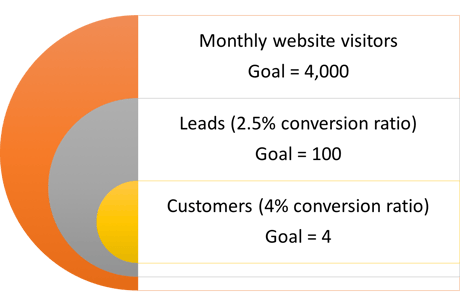A SMART Goal-Setting Process for Business Development and Growth

For those of you working on a plan to hit your business development goals, this post is for you. Many professional services businesses do great work for clients, but struggle to develop a consistent, scalable growth process. And growth is what makes everything happen in your business.
Like anything else, a well-defined sales process based on SMART goals increases the likelihood that you will succeed. Processes are repeatable and measurable. They are easy to communicate to teams so you communicate your value consistently in the marketplace. Because they are measurable, you can periodically adjust tactics - doing more of what's working and less of what isn't. And after all, doesn't it sound better than just winging it?
SMART Goals are specific, measurable, attainable, relevant and time-related. Here is a SMART goal-setting process for business development and growth.
Start at the end
The first SMART goal you set should be the big one - in order for your business to be where you need it to be at the end of the next accounting period, how much top-line revenue do you have to generate? Many of us are developing business plans for 2016, they should start with your total revenue target.
Once you have defined your revenue target, the next step is to develop a cascading series of SMART goals based on each lead generation channel you have.
With a well-defined target market and service profile, you should have a good idea of your average deal size. This will help you determine how much existing business you need to keep and how much new business you need to sell to hit your revenue targets.
Here's an example of how that might work. An IT consultant has an average deal size of $50,000 and a revenue goal of $2 million. Their monthly new business target is $500,000. This company needs to sell 10 new deals in their target market to hit their goals. The company has booked deals going into the year worth of $1.6 million. so they need to lose no more than 2 customers to hit goals.
| Revenue source | Dollars | Customers |
| New business | $.5 million | 10 |
| Booked business | $1.5 million | 30 |
| Total | $2 million | 40 |
These high-level goals cascade through the organization and help determine investments in operations and business development.
Break down new business goals by marketing channel
Once you've identified your new business goals, you need to assign portions of the total goal to each of your marketing channels. Most professional services businesses have at least the following marketing channels:
- Inbound marketing
- Referral selling
- Networking
- Outbound marketing
Let's take the case of the business above with a $500,000 monthly new business goal. Based on their marketing mix and their experiences working with it, they break down the new business goal as follows.
| Marketing channel | Customer goal | Revenue goal |
| Inbound marketing | 4 | $200,000 |
| Referral selling | 2 | $100,000 |
| Networking | 2 | $100,000 |
| Outbound marketing | 2 | $100,000 |
| Total | 10 | $500,000 |
Define sales process milestones for each channel
All of your marketing channels include milestones that a potential buyer touches in order to become a customer. Let's take the inbound marketing lead generation channel. A customer has to visit your website, convert into a lead and then convert into a customer. So the milestones for the inbound marketing process are website visitors, leads and customers.
A simplified inbound marketing funnel looks like this.

In order to hit the monthly sales goal of 4 new customers, this company needs to get 4,000 visitors to their website each month. They need to convert 2.5% of these website visitors to leads, for a monthly total of 100. Of these 100 monthly leads, the company needs to convert 4% of these leads to customers to hit their new business goal. Note that we've broken down annual goals into periodic goals - in this case, monthly. We'll explain why that's important later in this post.
Go through a similar process for each of your marketing channels. Define the milestones that need to be accomplished and set SMART goals. If you haven't done so, this will help you define your sales processes and the activities you need to do to be successful.
This is a good time to do a reality check. For example, if you need 4,000 website visitors to hit your goal and you currently get 500 per month, 4,000 is probably not a realistic goal.
Define the resources and budget you need to hit your goals
Now that you know the level of activities that will define success, it's time to develop a plan to achieve the goals.Let's go back to the inbound marketing channel.
What do you need to do to get 4,000 website visitors per month? You will certainly need to blog to generate web traffic. Let's say you decide to blog three times per week to generate sufficient traffic. How will you produce three blog posts per week? Internally? Outsource? How much will it cost to create 3 quality blog posts per week?
You will also need to use social media to promote your blog and lead generation offers. Who will do that? How? What resources do they need? Software? Graphic design? You're probably getting the picture - the goals you set define the tactics and budget you need to achieve them.
Go through this process for each milestone in each of your marketing channels. Defining the levels of activity and tactics helps keep you on track throughout the year.
Monitor and adjust your sales plan to keep on track
Remember when I said it was important to break down your annual goals into periodic goals? Here's why - it will keep you on track throughout the year and allow you to adjust tactics based on results.
For example, if you're not hitting the monthly web traffic goals of 4,000 per month, you can adjust tactics to address the shortfall. In this case, you might decide to blog more frequently or you might use pay-per-click or social media advertising to increase web traffic.
By establishing and monitoring periodic goals, you avoid end of the year surprises.
Success is most often preceded by process. This holds true for business development. A well-defined business development process based on high-level goals increases your chances for success.





